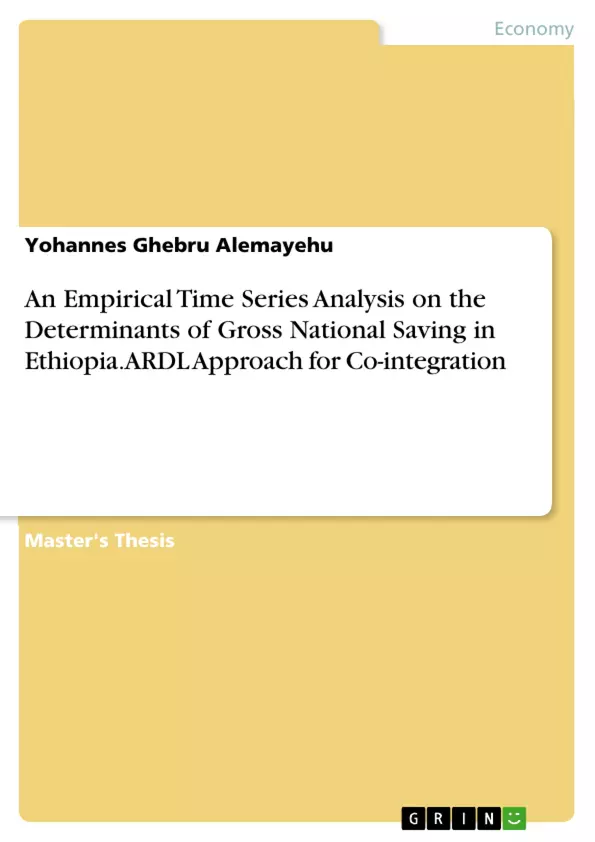The objective of this paper was to investigate the macroeconomic determinants of gross national saving in Ethiopia using time series annual data form 1970/71-2010/11. In this study, effort has been made to identify the long run and short run determinants of national saving in Ethiopia using an ARDL bounds testing approach and ECM to capture both short run and long run relationships. Estimated results revealed that financial development (FD) and Current account deficit (CAD) are significant determinants of gross national saving in Ethiopia in the long run. But gross national disposable income (LGNDI), dependency ratio (DR), budget deficit (BD) and inflation, approximated by consumer price index (CPI), found to be statistically insignificant determinants of gross national saving in Ethiopia in the long run.
However, in the short run, except consumer price index (CPI) and dependency ratio (DR) the rest of the explanatory variables such as gross national disposable income (LGNDI), financial development (FD), current account deficit (CAD) and budget deficit (BD) found to have statistically significant meaning in explaining gross national saving in Ethiopia. The speed of adjustment has value 0.66978 with negative sign, which showed the convergence of saving model towards long run equilibrium. The overall findings of the study underlined the importance of raising the level of income in a sustainable manner, minimizing the adverse impacts of budget deficit and inflation rate and creating competitive environment in the financial sector.
Inhaltsverzeichnis (Table of Contents)
- Abstract
- Acknowledgments
- List of Tables
- List of Figures
- Chapter 1: Introduction
- 1.1 Background of the Study
- 1.2 Statement of the Problem
- 1.3 Objectives of the Study
- 1.3.1 General Objective
- 1.3.2 Specific Objectives
- 1.4 Significance of the Study
- 1.5 Scope of the Study
- 1.6 Organization of the Study
- Chapter 2: Literature Review
- 2.1 Theoretical Framework
- 2.2 Empirical Review
- 2.3 Summary of the Literature
- Chapter 3: Methodology
- 3.1 Data and Sources
- 3.2 Model Specification
- 3.2.1 The Augmented Dickey-Fuller (ADF) and Phillips-Perron (PP) Unit Root Tests
- 3.2.2 The ARDL Bounds Testing Approach to Co-integration
- 3.2.3 The Error Correction Model (ECM)
- 3.3 Estimation Techniques
- Chapter 4: Empirical Results and Discussion
- 4.1 Preliminary Data Analysis
- 4.1.1 Time Series Plot of the Variables
- 4.1.2 Descriptive Statistics of the Variables
- 4.1.3 Correlation Matrix of the Variables
- 4.2 Unit Root Test
- 4.3 Co-integration Test
- 4.4 Long-Run Estimation
- 4.5 Short-Run Estimation
- Chapter 5: Conclusions and Policy Implications
Zielsetzung und Themenschwerpunkte (Objectives and Key Themes)
This paper aims to investigate the macroeconomic determinants of gross national saving in Ethiopia. The analysis uses annual time series data from 1970/71-2010/11, applying an ARDL bounds testing approach and the Error Correction Model (ECM) to identify both long-run and short-run relationships.- Investigate the long-run and short-run determinants of gross national saving in Ethiopia.
- Employ the ARDL bounds testing approach and ECM to capture both long-run and short-run relationships.
- Analyze the impact of financial development, current account deficit, gross national disposable income, dependency ratio, budget deficit, and inflation on gross national saving.
- Determine the speed of adjustment towards long-run equilibrium.
- Derive policy implications based on the empirical findings to promote sustainable growth and development.
Zusammenfassung der Kapitel (Chapter Summaries)
- Chapter 1: Introduction: This chapter introduces the research topic, defines the problem, outlines the objectives and significance of the study, and describes the scope and organization of the paper.
- Chapter 2: Literature Review: This chapter presents a comprehensive review of the relevant literature on saving behavior, focusing on both theoretical and empirical studies.
- Chapter 3: Methodology: This chapter details the data used for the analysis, the econometric model specification, and the estimation techniques employed.
- Chapter 4: Empirical Results and Discussion: This chapter presents the findings of the empirical analysis. It examines the preliminary data analysis, conducts unit root tests, performs co-integration tests, estimates the long-run and short-run relationships, and discusses the implications of the results.
Schlüsselwörter (Keywords)
The primary focus of this research is the analysis of gross national saving in Ethiopia. The study investigates the role of macroeconomic variables such as financial development, current account deficit, gross national disposable income, dependency ratio, budget deficit, and inflation as determinants of saving behavior. The research utilizes time series analysis, particularly the ARDL bounds testing approach and the Error Correction Model (ECM), to uncover both long-run and short-run relationships. The keywords encompass themes of national saving, economic growth, financial development, macroeconomic determinants, ARDL approach, co-integration, and time series analysis.- Arbeit zitieren
- Yohannes Ghebru Alemayehu (Autor:in), 2014, An Empirical Time Series Analysis on the Determinants of Gross National Saving in Ethiopia. ARDL Approach for Co-integration, München, GRIN Verlag, https://www.grin.com/document/281887



